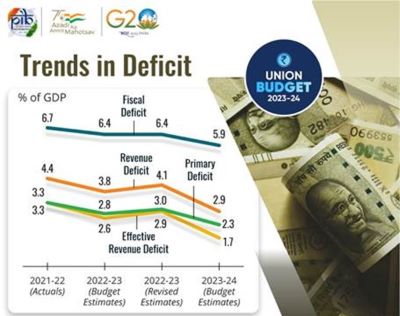Context-
Government expenditures that significantly exceed revenue can destabilize the economy. In the 1980s, India's rising fiscal deficit and mounting government debt led to a challenging balance of payments situation and an increasing ratio of interest payments to revenue receipts. This forced the government to borrow excessively to fund developmental expenditures, underscoring the importance of fiscal prudence.
Budgetary Goals and Fiscal Deficit Targets
● 2024-25 Union Budget Targets
In the 2024-25 Union Budget, the Finance Minister outlined a commitment to reducing the fiscal deficit. From 2026-27 onwards, the government aims to ensure the Central government debt follows a declining path as a percentage of GDP. The fiscal deficit is projected to decrease to 4.5% of GDP in 2025-26 from 4.9% in 2024-25.
● Projected Debt-GDP Ratios
Assuming a nominal GDP growth of 10.5% over the next two years, the Centre’s debt-GDP ratio is expected to reach 54% by 2025-26. However, the government has not provided a specific debt-GDP target or a clear path to achieve it, indicating a shift away from the Fiscal Responsibility and Budget Management (FRBM) Act of 2018, which aimed for a 40% debt-GDP ratio for the central government and 60% for the combined government.

Implications of Fiscal Deficit Levels
● Potential Impact on Private Sector Investment
Maintaining a fiscal deficit of 4.5% of GDP could help reduce the debt-GDP ratio over time, reaching around 48% by 2048-49. However, state governments have set their fiscal deficit targets at 3% of GSDP. If both central and state governments adhere to these targets, the combined fiscal deficit could average 7.5% of GDP, potentially limiting the private sector’s access to investible surplus unless the current account deficit is increased beyond sustainable levels.
● Analysis by the Twelfth Finance Commission
The Twelfth Finance Commission observed that the investible surplus for the private sector could be derived from household financial savings and net foreign capital inflow, minus the borrowing needs of central and state governments. It noted that a household savings rate of 10% of GDP, coupled with a 1.5% current account deficit, could support a sustainable government fiscal deficit of 6%, while still allowing the private sector and public enterprises to absorb investment funds.
● Declining Household Financial Savings
Recent trends show a decline in household financial savings, which fell to 5.3% of GDP in 2022-23 from 7.6% in the previous four years (excluding the COVID-19 year of 2020-21). With household savings at 5.3% and net foreign capital inflows at about 2%, the total investible surplus of 7.3% would be almost entirely consumed by government fiscal deficits, leaving little room for private investment unless household savings increase.
The Relationship Between Fiscal Deficit and Debt-GDP Ratio
● Fiscal Deficit's Impact on Debt Levels
There is a direct relationship between the fiscal deficit and the debt-GDP ratio. To lower the debt-GDP ratio, the fiscal deficit must be reduced, thus minimizing the year-over-year change in debt levels. India’s fiscal responsibility framework, including the FRLs of the Centre and States since 2003, has aimed to align fiscal deficit targets with appropriate debt-GDP/GSDP levels.
● Consequences of High Debt Levels
High debt-GDP ratios, compared to the FRL norms, would lead to higher interest payments relative to revenue receipts, straining government finances. The central government’s interest payments relative to revenue receipts (net of tax devolution) have increased to an average of 38.4% during 2021-22 to 2023-24, up from 35% in 2016-17. Including all transfers, this ratio averages 51.6%, highlighting the fiscal strain caused by high debt levels.
International Comparisons
● Debt Management in Other Countries
Many countries have higher government debt-GDP ratios than India but manage to keep their interest payments relative to revenue receipts significantly lower. Between 2015-19, Japan, the United Kingdom, and the United States had average ratios of interest payments to revenue receipts at 5.5%, 6.6%, and 8.5%, respectively. In contrast, India’s combined ratio was much higher at 24% during 2015-16 to 2019-20, with the Centre's post-transfer ratio averaging 49%.
● Need for a Clear Fiscal Strategy
India’s higher ratios highlight the need for a clear fiscal strategy. Although recent statements emphasize the debt-GDP ratio as a key policy variable, India lacks a defined target and path to achieve sustainable debt levels. This leaves the economy vulnerable to external shocks, such as the COVID-19 pandemic, which sharply increased the central debt-GDP ratio from 50.7% in 2019-20 to 60.7% in 2020-21.
Major Recommendations by the Confederation of Indian Industry (CII):
1. Fiscal Consolidation:
○ Reintroduce medium-term deficit indicators in the Union Budget for better fiscal planning.
○ Update the Fiscal Responsibility and Budget Management Act as per the 15th Finance Commission’s suggestions.
○ Develop a strong fiscal framework to improve India’s credit rating.
2. Healthcare and Education Spending:
○ Increase government spending on healthcare to 3% of GDP and on education to 6% of GDP by 2030-31.
3. Boosting Capital Spending:
○ Use part of the ₹2.1 trillion RBI dividend to increase capital spending by 25% from 2023-24 levels, to spur public and private investment.
4. Disinvestment & Asset Monetization:
○ Adopt a demand-driven approach for PSE divestment.
○ Strengthen the asset monetization program by assisting ministries and state governments in identifying assets and improving regulatory processes.
○ Set up a dedicated unit in Niti Aayog or the Ministry of Finance to oversee these initiatives.
5. Taxation Reforms:
○ Implement a simplified three-rate GST structure with lower rates to enhance tax compliance and business ease.
○ Include petroleum products and electricity under GST to reduce costs through input tax credits.
Conclusion
Returning to pre-crisis debt-GDP levels has been slow and challenging, with upward adjustments following economic shocks often proving asymmetric. Governments tend to delay reducing the debt-GDP ratio, maintaining high interest payment obligations that constrain fiscal resources.
Given the current low levels of household financial savings, the central government should adhere to a strict fiscal deficit limit of 3% of GDP to ensure fiscal prudence. A detailed roadmap to achieve this target is crucial, as any relaxation of this rule could lead to fiscal imprudence, undermining long-term economic stability and growth.
|
Probable Questions for UPSC Mains Exam- 1. Discuss the implications of maintaining a high fiscal deficit on the private sector's access to investible surplus in India. How does the government’s fiscal policy impact the country's debt-GDP ratio and overall economic stability? (10 Marks, 150 Words) 2. Critically evaluate the major recommendations of the Confederation of Indian Industry (CII) on fiscal consolidation and their potential impact on India's economic growth and fiscal sustainability. What steps should the government take to ensure effective implementation of these recommendations? (15Marks, 250 Words) |
Source- The Hindu







